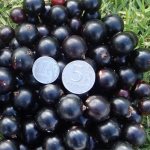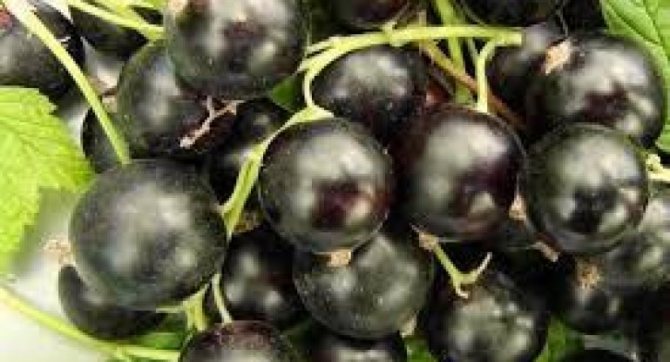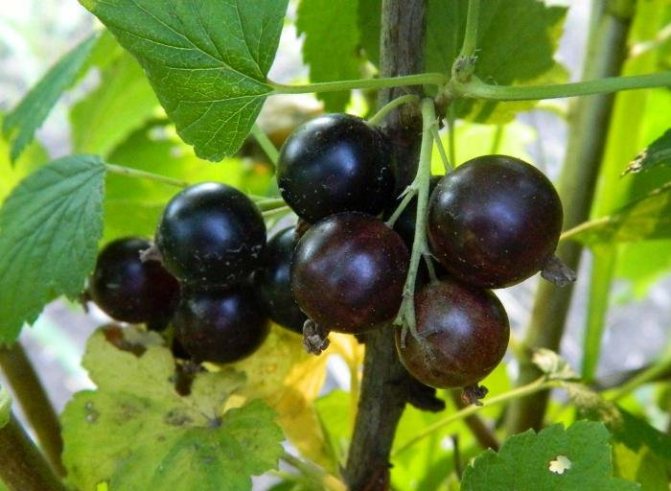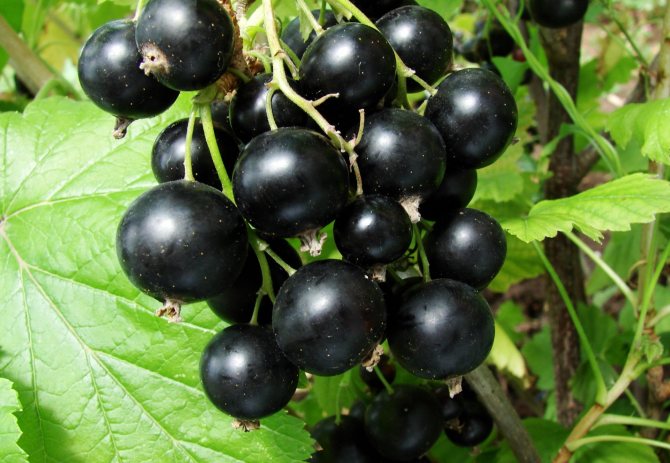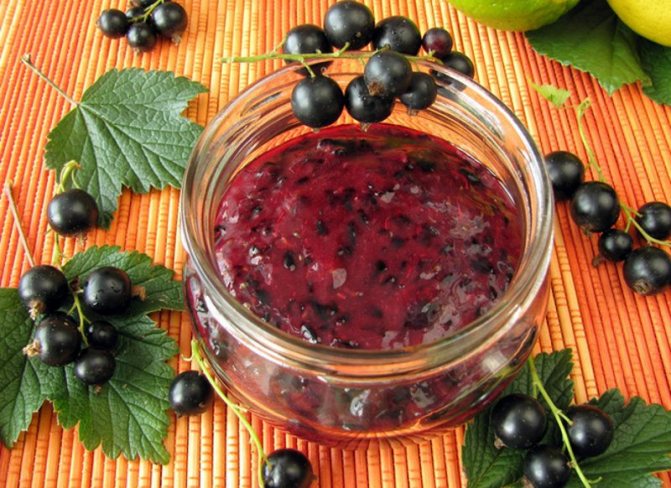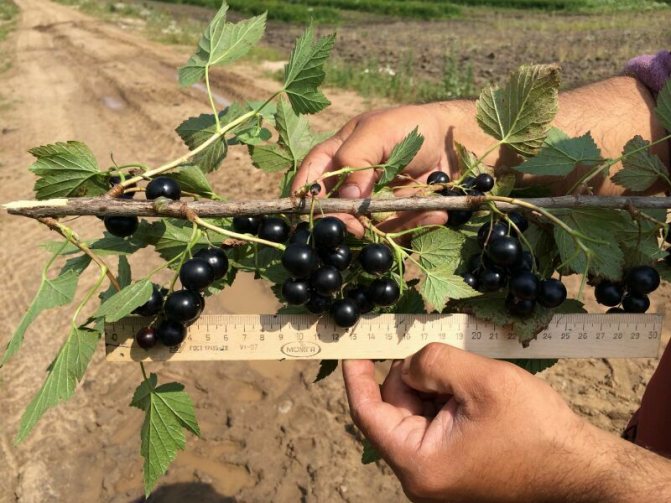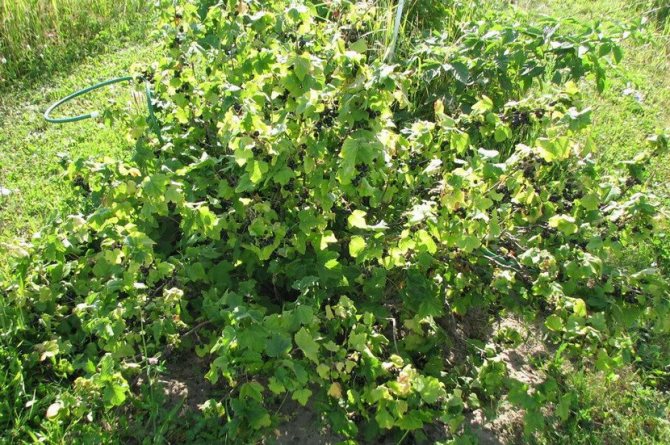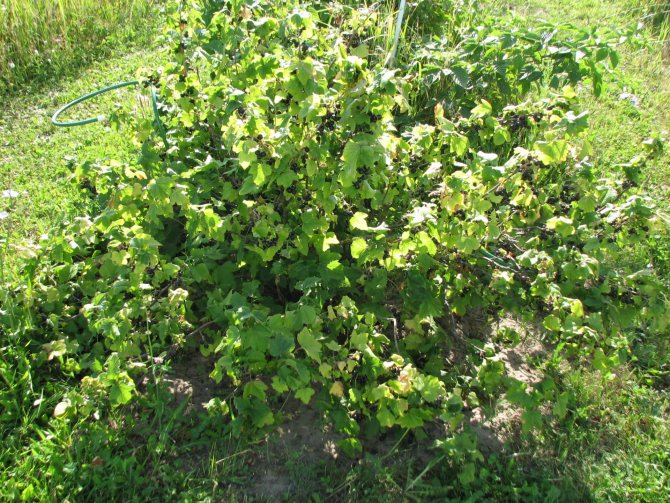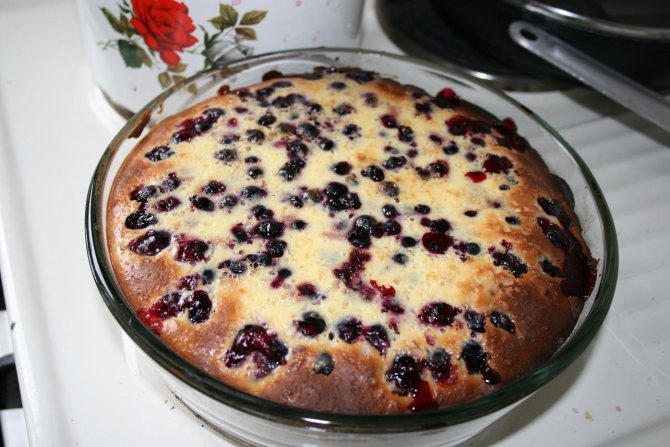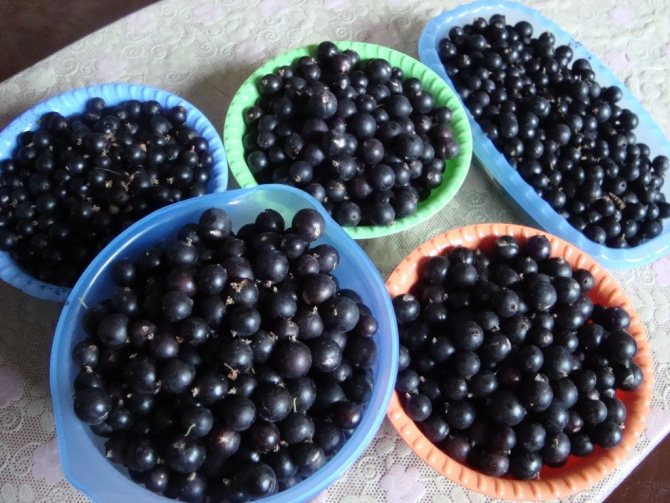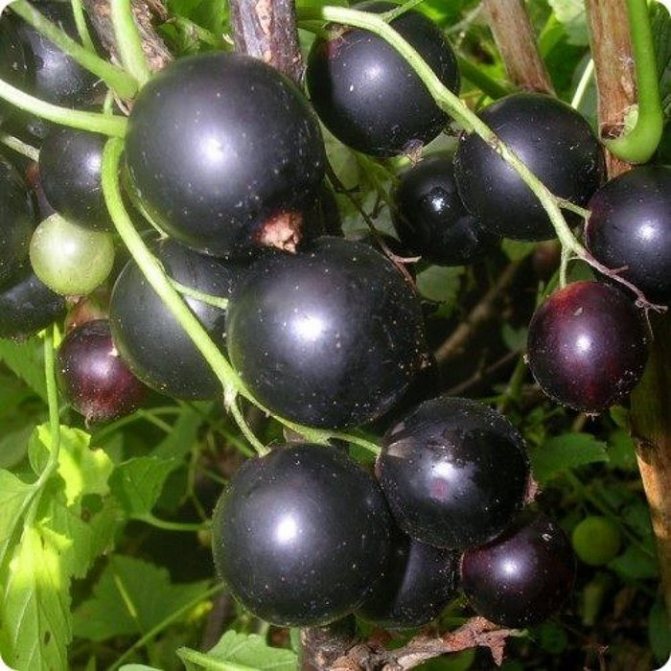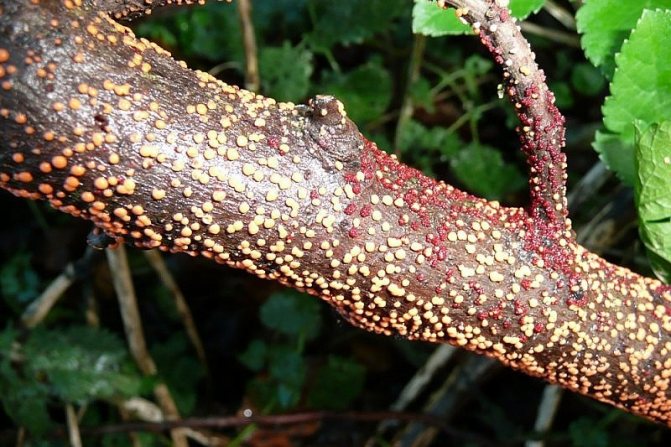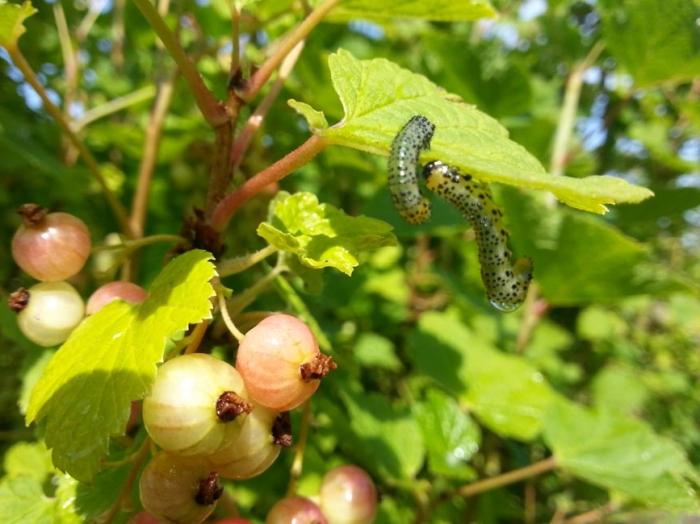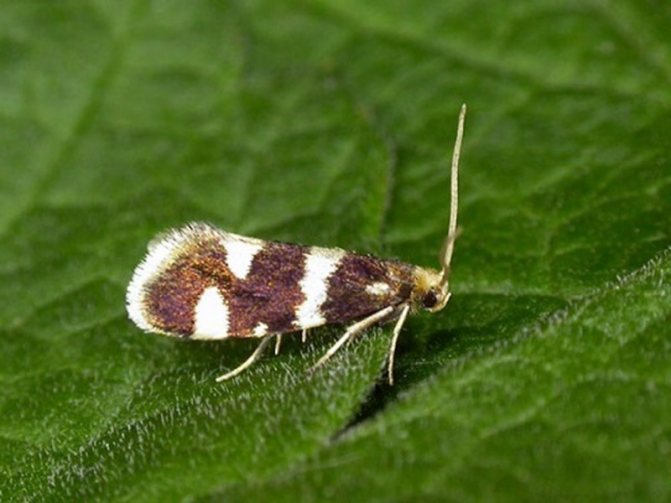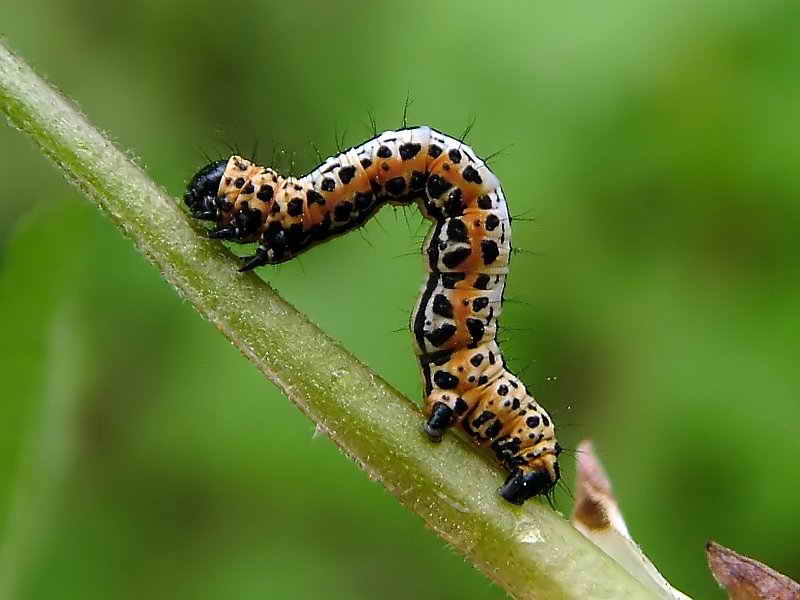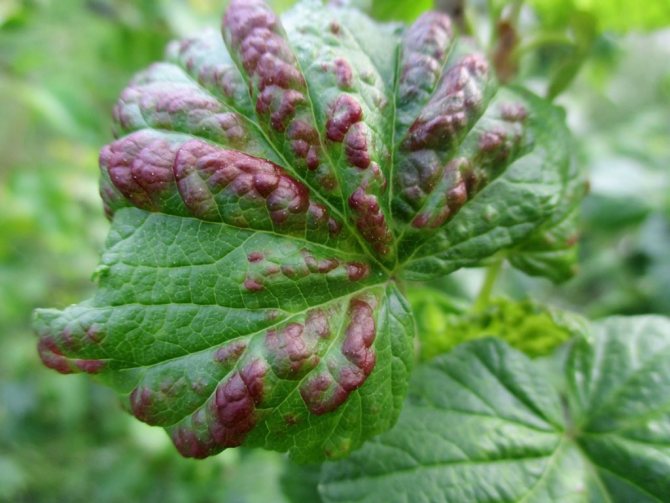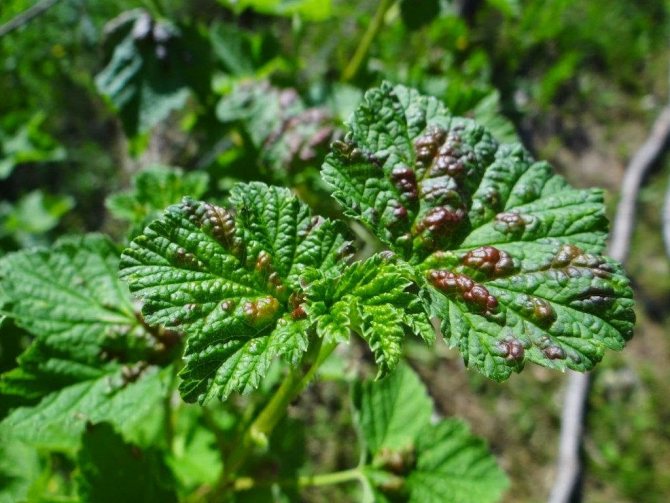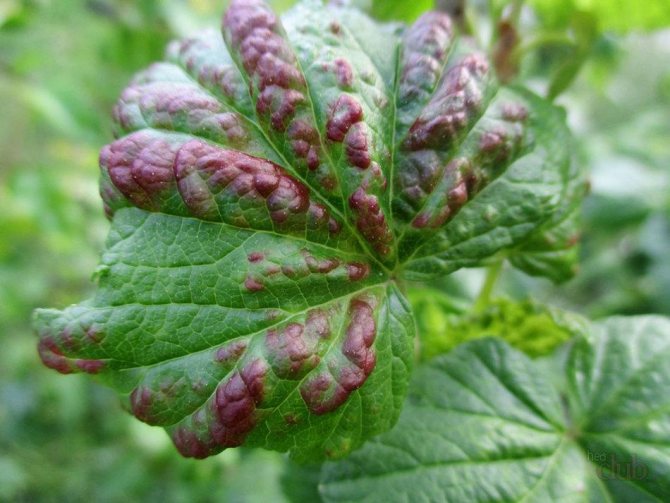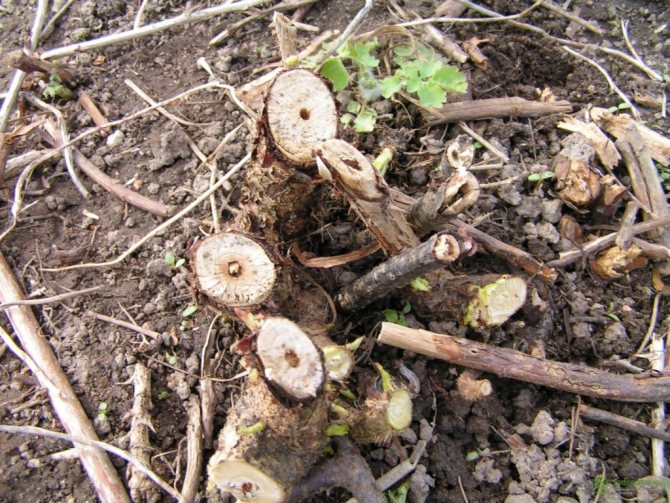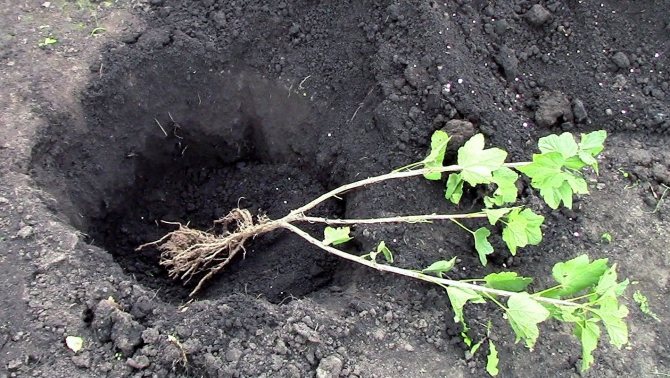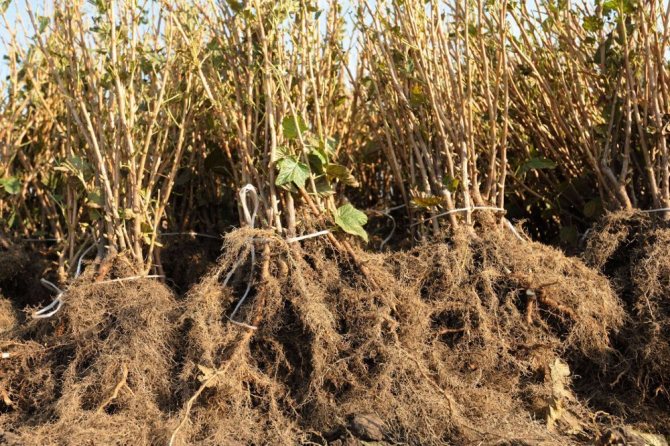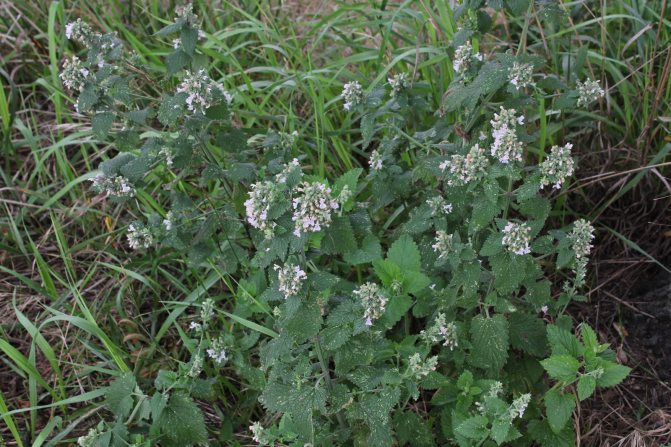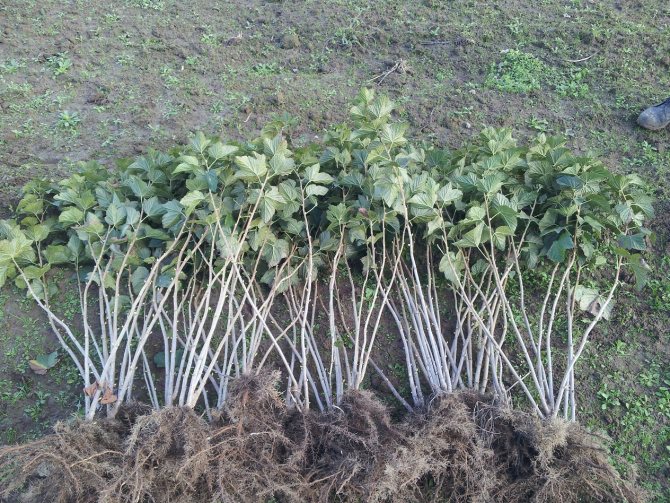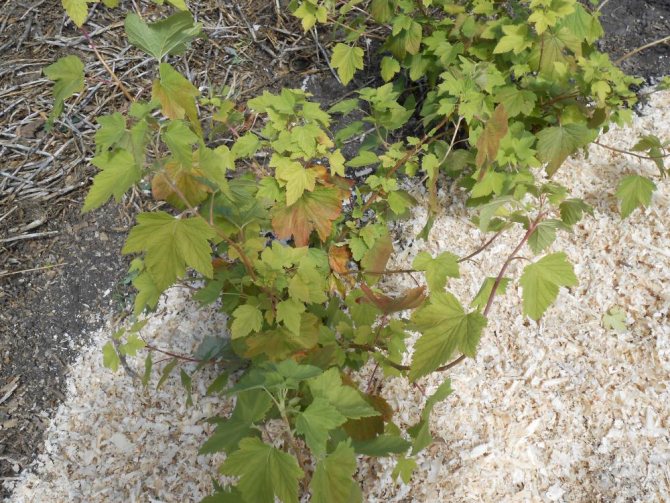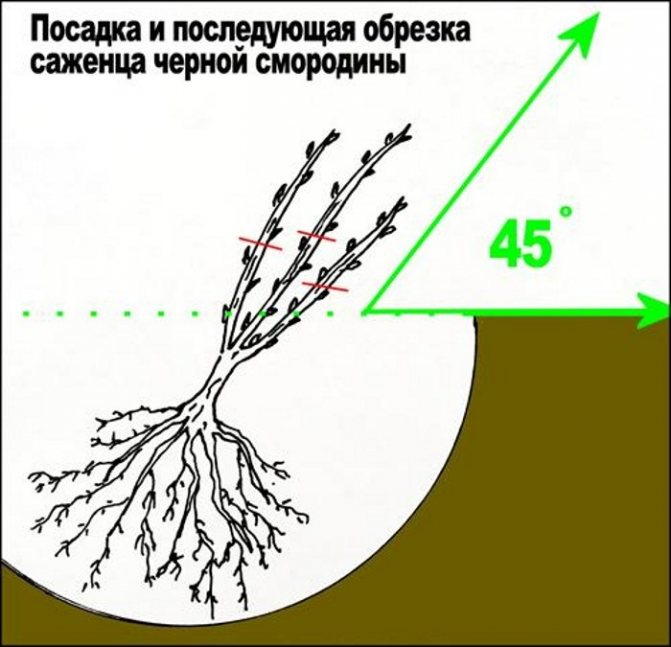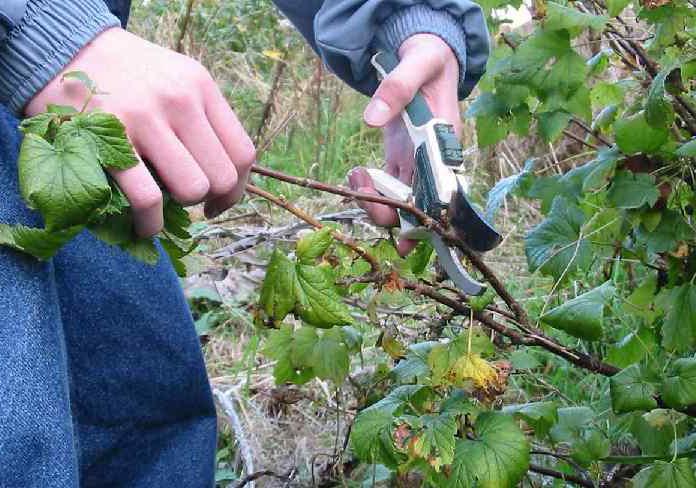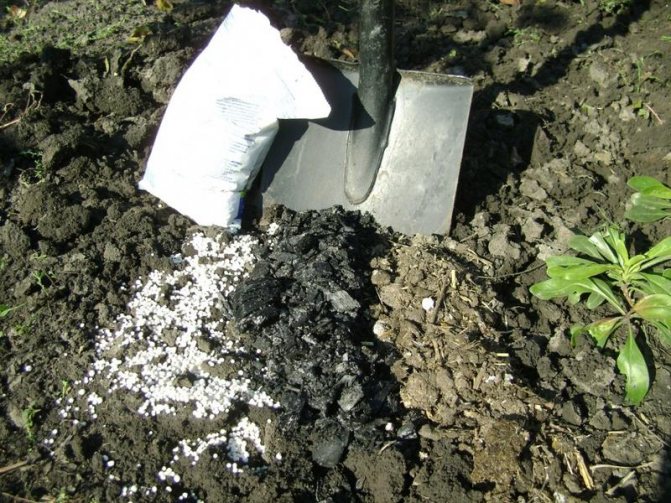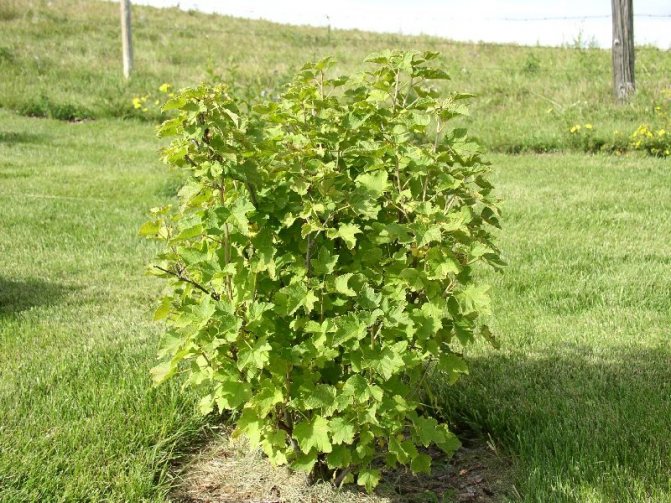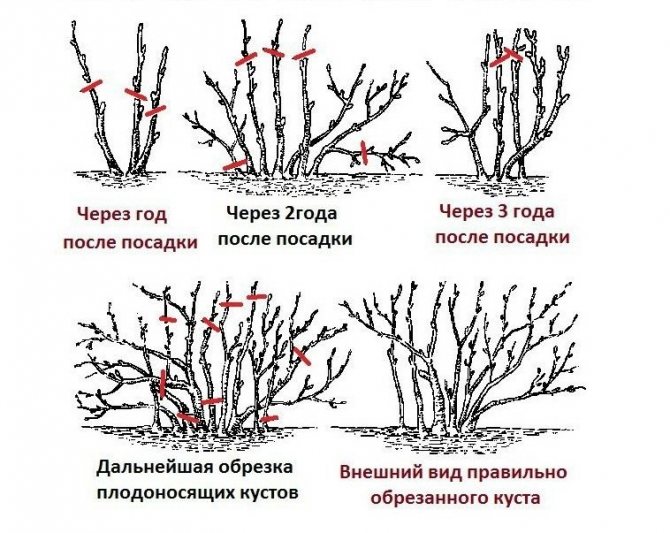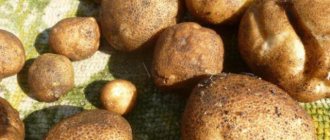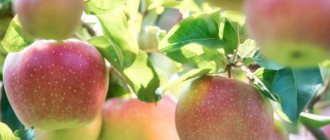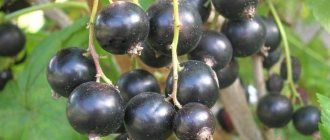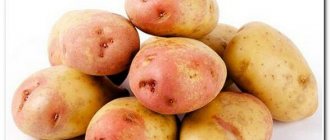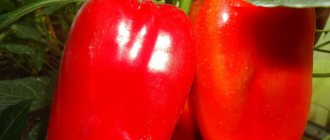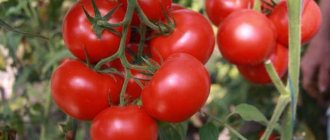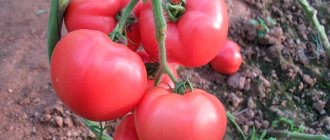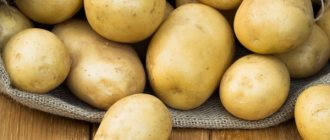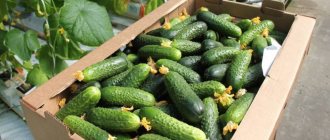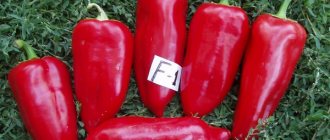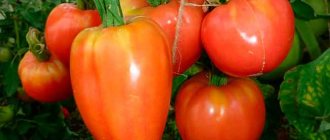Variety of black currant Yadrenaya: description, photos, reviews, yield, cultivation, planting and care
One of the most popular berry bushes with healthy fruits is black currant. It can be found in almost any garden.
But gardeners periodically update the berry bushes available in the garden, wishing to acquire such varieties of perennial berries that would have improved characteristics: increased productivity, large-fruited, resistance to major diseases, resistance to frost.
This article will talk about the variety of black currant Yadrenaya, regions of growth, yield and many other positive characteristics.
... There is also an improved variety on sale - the black currant Yadrenaya-2, which is distinguished by an increased yield in relation to the currant Yadrenaya and larger sizes of ripe berries.
The content of the article:
1. Variety history 2. Vigorous currant: characteristics and description 3. Variety yield 4. Advantages and disadvantages 5. Diseases and pests 6. Reproduction of Yadrenaya currant 7. Planting and cultivation 8. Further care of the Yadrenaya variety 9. Top dressing of currants 10. Currant pruning 11. Reviews for black currant Yadrenaya
Main characteristics
The beginning of the growing season and flowering depends on the growing region. The originator indicates that flowering takes place in May, and ripening is completed by mid-August. Among the main characteristics of the variety, the following are noted.
| Characteristics of the variety | Description |
| Name | black currant variety "Vigorous" |
| Year of registration on the territory of Russia | 2000 |
| Appointment | universal |
| Maturation | mid-late |
| Frost resistance | good |
| Drought tolerance | average |
| Yield | up to 4 kg per bush |
| Shape, color of berries | rounded, deep ink color |
| Transportability | low, berries are damaged during transportation |
| Safety | after harvest, the berries are kept fresh for up to 5 days at a temperature of +4 ° C, suitable for making juices, jams, freezing |
The fruits that darken at the beginning of August are not picked immediately, but they are allowed to ripen well. In this case, the berries acquire a rich currant flavor and sugar content. They make nutritious vitamin drinks: fruit drinks, teas, juices, cocktails.
Pros and cons of the variety
Noting the advantages and disadvantages of the variety, gardeners stop at the following.
| Advantages | disadvantages |
| Fast fertility (fruiting of currants begins from the second year after planting in a permanent place) | Systematic crown formation is required |
| Large berries (7-8 g) | After 5-7 years, currants need to be uprooted, new bushes should be planted, as the culture begins to ache, bear fruit poorly, dry |
| Abundance of fruit (with good watering, fertilization and sufficient sunny days) | Berries Vigorous do not tolerate transportation due to delicate skin (crumple, burst) |
| Excellent winter hardiness (without shelter for the winter period Yadrenaya can withstand temperatures down to -30 ° C) | The disadvantages include sourness, which is present due to the high content of useful ascorbic acid in the pulp - about 96% |
| Virus resistance |
Description of berries
The taste of berries Vigorous according to the assessment of professional tasters - 4.3 points. Tasters note the balance of acidity and sweetness, the richness of the taste of ripe currants. Currant fruits ripen at the same time, hold tight to the bunch, do not crumble, do not crack. They have the following biological characteristics:
- width - 1.5-1.9 cm;
- length - up to 2 cm;
- weight - on average 3.2 g, maximum up to 7 g;
- the pulp is fleshy with the presence of small seeds.
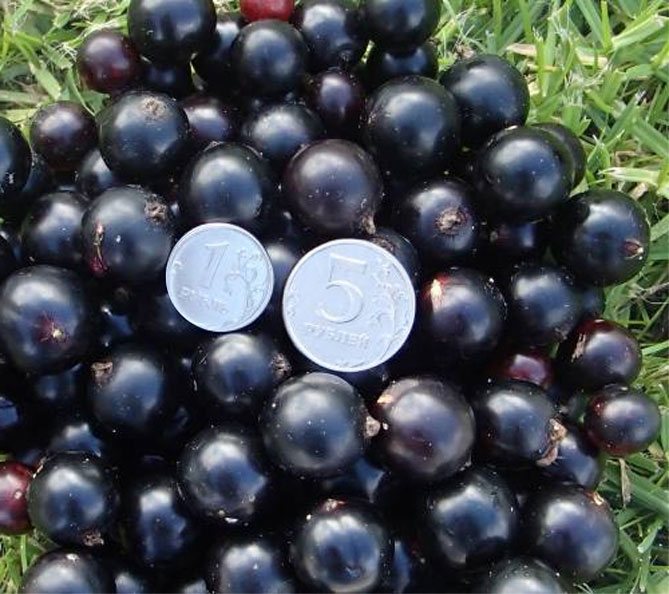
Advice. In order to prevent and treat colds, housewives prepare fresh currants, grated with sugar. It is mixed in 1/1 proportions, ground and placed in a refrigerator in screwed jars.
Description of the bush, pollinators
A photo of black currant bushes characterizes them as medium-sized, not too spreading. The maximum height of adult plants is no more than 1.5 m. Straight-growing shoots develop at an average speed, intensive growth is observed in the spring.
The plant has the following characteristics:
- the leaves are serrated, fragrant, painted green with purple veins;
- flowers are small, beige, collected in inflorescences of 7-13 pieces;
- young branches are colored light green, eventually become burgundy, and then gray-brown.
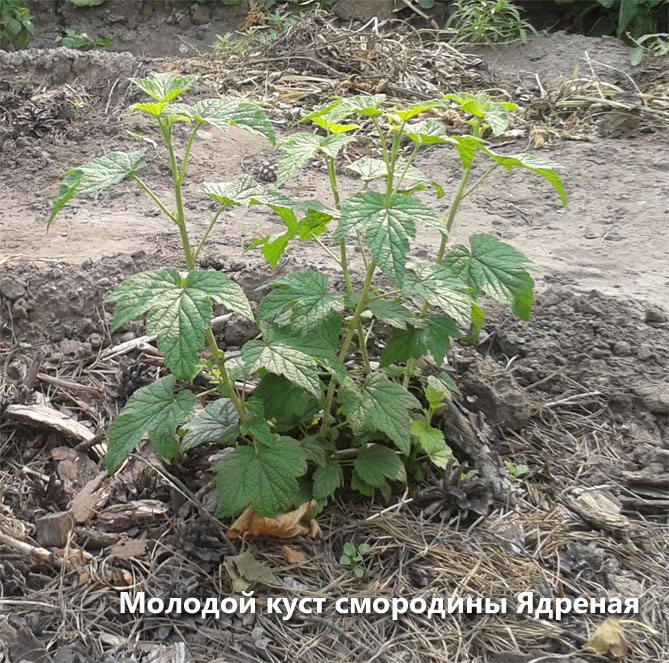

Drought resistance and frost resistance
Due to the fact that Yadrenaya was bred for cultivation in the extreme conditions of the Siberian region, the variety is resistant to low temperatures. It is not required to cover the bushes for the winter. During dry summers, the crop does not die without watering, but the lack of water affects the formation and development of fruits. Without systematic watering, the crop is sprinkled (irrigation rate is every 3 days, 10-12 liters under a bush in the absence of rain).
Productivity, ripening time
According to the passport characteristics, Yadrenaya is a variety with moderate fruiting. The first fruits are tied 2-3 years after planting the seedling. The maximum number of currant berries is harvested at 4-6 years of plant development. In Altai and Siberia, flowering begins in mid-May. Ripe fruits are harvested in stages, starting in August. It is not recommended to immediately remove the berry in bunches.
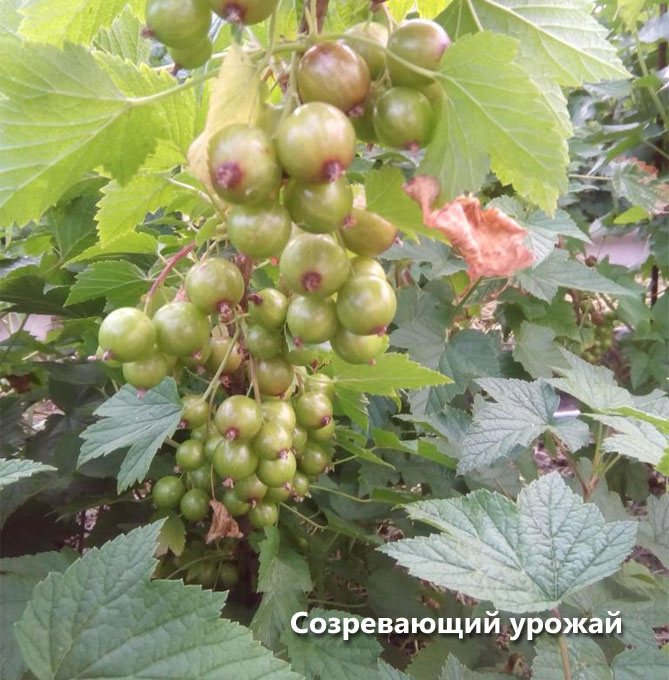

Disease and pest resistance
Diseases and pests are not terrible for currants if in early spring preventive treatment of the peri-stem circle with urea infusion was carried out, and in late autumn the bushes were sprayed with Fitoverm solution (according to the instructions). In varietal tests, resistance to powdery mildew was revealed, anthracosis, and the effect of a tick were weakly manifested.
However, aphid damage is possible.
Variety history
Black currant Yadrenaya was brought out by breeders from Gorno-Altaysk at the end of the last century. This variety was bred specifically for cultivation in Siberia and other Russian regions with a similar climate, therefore, one of the main characteristics of this berry perennial was its high resistance to frost.
But still one of the main advantages of the Yadrenaya currant is the large size of its berries
, as a result, the variety is today considered one of the largest-fruited. Currently, the variety has become famous and popular among gardeners not only in Russia, but also in many other countries.
The originator of the idea was the breeder Zabelina L.N., who created a hybrid that was obtained by crossing the Brebthorp and Dikovinka varieties with the Lyubimitsa Altai currant. This berry perennial was bred in the early 90s of the last century, passed tests and in 2000 was entered into the State Register of Russia.
Black currant Vigorous is recommended for cultivation in the Volgo-Vyatka and West Siberian regions of Russia
... However, the characteristics of this berry perennial allow it to be grown in most Russian regions.
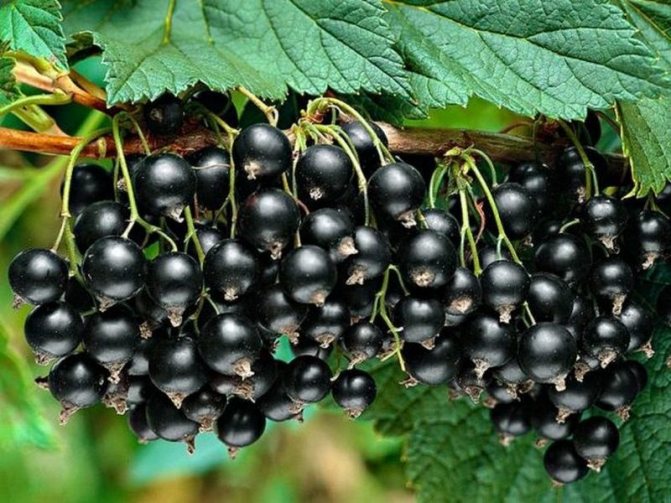

Poisonous black currant: characteristic of berries
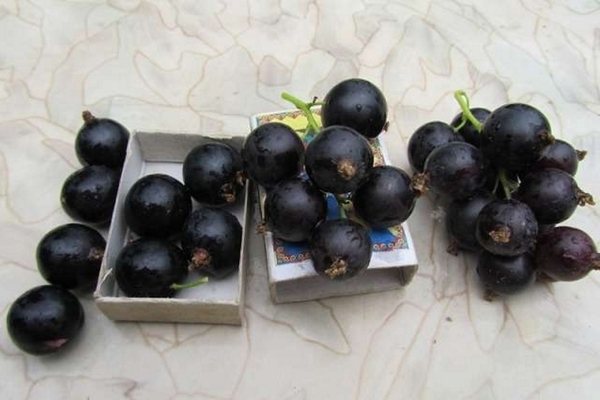

Black currant variety Vigorous photo
As you already imagined at the beginning, Viper has huge berries, so if you want to get a very bountiful harvest, then this variety will certainly suit you. The fruits of this black currant are very large. The berries are round, slightly oblong in shape. If we talk about the size, it should be noted that the berries reach one and a half centimeters in width, and in length - 2. The fruits of this black currant are a bit like grapes or cherries. One berry weighs 5 to 8 grams. But usually the berries are the same, and the harvest ripens together. The rind is thin enough, but firm, the flesh is firm. Usually the berries are dull in color, when ripe they first turn brown and then black.
After you pick the fruits, the berries do not let the juice out, so it is very convenient to transport it. Brushes are stored for a very long time after harvest. If we talk about the taste, the berries have a pleasant aroma and a fairly sweet taste. Many gardeners note that the fruits of this variety are quite sour, but during the ripening process they are filled with sugars, therefore, with technical ripeness, the fruits are very sweet. They contain a lot of sugars, ascorbic acid, as well as trace elements useful for humans. The fruits of this black currant can be frozen for the winter, ground with sugar, and can also be preserved. These berries make wonderful jams, jams and compotes. As we have already noted above, many hostesses prepare excellent fillings for pies from black currant. Can be made with currants and jelly. Despite the fact that the juice of the berries is not allowed immediately, it should not be transported too far, as the product may deteriorate.
Currant Vigorous: characteristics and description of the variety
The growth of shoots of this shrub is restrained, over the years of growth, the height of this currant can reach 1.4-1.5 m. The bushes of the currant Vigorous are not too spreading, the plant is sparse enough, so all the fruits are well illuminated by the sun's rays.
Shoot thickness is medium, but older shoots are thicker. The color of the bark is green, with a slight anthocyanin coloration. The pubescence of the stems is weak. In lignified shoots, the color of the bark is light or dark brown.
![Tinkoff (Debit Card) [CPS] RU](https://bgn.imadeself.com/wp-content/uploads/tinkoff-debetovaya-karta-cps-ru7.jpg)
![Tinkoff (Debit Card) [CPS] RU](https://bgn.imadeself.com/wp-content/uploads/tinkoff-debetovaya-karta-cps-ru7.jpg)
Buds are medium in size, ovoid, with pointed tops, apical, slightly deviated from the shoots, usually located in several pieces in nodes. Their color is deep red, with slight pubescence.
Currant Yadrenaya - photo
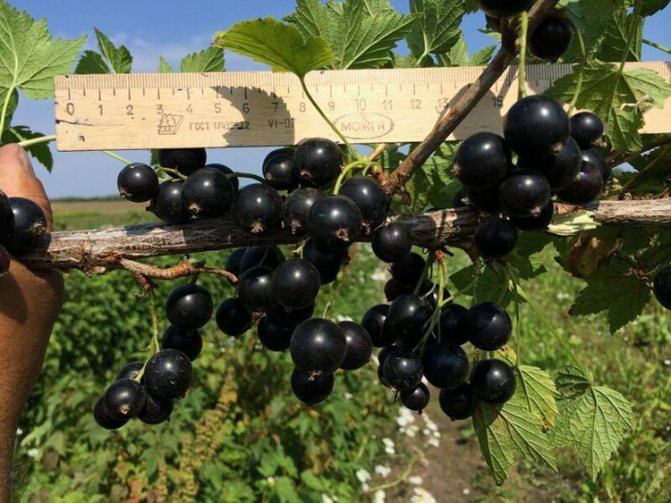

Black currant foliage Vigorous - standard five-lobed, shiny, leathery, dark emerald color, slightly wrinkled and bubbly. The leaves do not have pubescence, the veins on the leaf blades are deeply impressed. The main veins have a dark pink color.
On the edges of the foliage there are wide teeth, slightly bent. Cream-colored dots are visible along the entire surface of the wide teeth. The petioles are of medium length and thickness, pinkish and slightly pubescent.
Currant variety!
• Dobrynya
The flowers are medium in size, the petals are of a pale pink hue, collected in racemose elongated inflorescences. In each of them, up to 10-12 ovaries are formed that do not close together.
Important!
Of the varieties of domestic selection, Yadrenaya currant is the largest-fruited - the size of ripe berries is up to 2 cm in length and up to 1.6 cm in width.
Fruits are round, occasionally slightly oblong, plum-shaped. Sometimes you can confuse the berries of this black currant with a cherry in size.
Photo of currants on a bush variety Yadrenaya
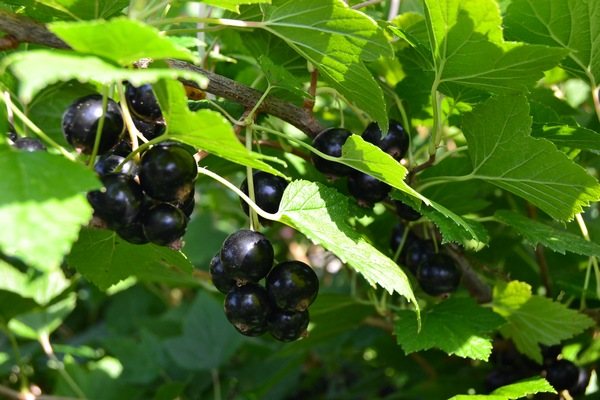

The mass of a ripe fruit of a vigorous currant can reach 7-8 g. The harvested crop differs in approximately the same size of berries. The pulp is fleshy, rather sweet, with a high content of seeds. Thin and tough skin is practically not prone to cracking. Its color is black, without a pronounced gloss.
When the berries are torn off the stalk, juice does not appear, and when picked with brushes, the crop may not crumble for a long time.
Important!
Ripe black currant fruits have a vigorous amazing aroma and pleasant sweet taste with a slight sourness. If summer residents do not like the amount of acid in the harvested berries, then you should not rush to collect them and let them hang until they are fully ripe - in this case, the amount of sugars in the fruits increases dramatically.
The harvested crop contains up to 8.9% of sugars, vitamin C - 95 mg / 100 g, the amount of dry matter - about 10%, tetrized acidity - about 3.6%. Tasting assessment of berries - 4.4 points on a 5-point scale.
Harvested berries are versatile. Most often, the resulting crop is frozen for the winter, or ground with sugar - with this method of harvesting, all vitamins and useful substances are preserved. You can also prepare compotes, jams, preserves.
The fruit stalks of the berries are thick, elongated, with slight pubescence, capable of holding large fruits.
Currant Yadrenaya - video
The harvested variety Yadrenaya does not tolerate transportation well
, when transported over long distances, the berries crumple and release juice.
Currant variety Yadrenaya is late-ripening
- fruits ripen in the last decade of July; in colder regions, fruiting can occur in the first decade of August. The berries ripen together, in a few days, which is very beneficial for those gardeners who grow black currants for sale.
Blackcurrant Vigorous is resistant to frost
, without shelter, it can withstand cold up to -30 degrees Celsius, with snowy winters - up to -40. Also, this berry can easily endure heat and drought, without losing flowers and ovaries. Therefore, Yadrenaya currant can be grown in almost all Russian regions.
Important!
The black currant variety is vigorous self-fertile, therefore it does not require the presence of a number of other pollinating bushes. But gardeners note that if other varieties of currants with the same flowering period grow nearby, then the yield of Yadrenaya increases due to cross-pollination.
The first harvest from this shrub is harvested in the next season after planting.
... But the maximum number of ovaries is usually formed on the branches of the 2nd and 3rd years.
Harvesting and transportation, keeping berries
In regions of the temperate climatic zone, the Yadrenaya currant begins to ripen closer to mid-July. In the southern regions, the berries reach their biological ripeness 2-3 weeks earlier, while in the northern regions, on the contrary, the harvesting period is delayed for exactly the same period. Regardless of the place of growth, the fruits ripen gradually, filling with a uniform dark color.
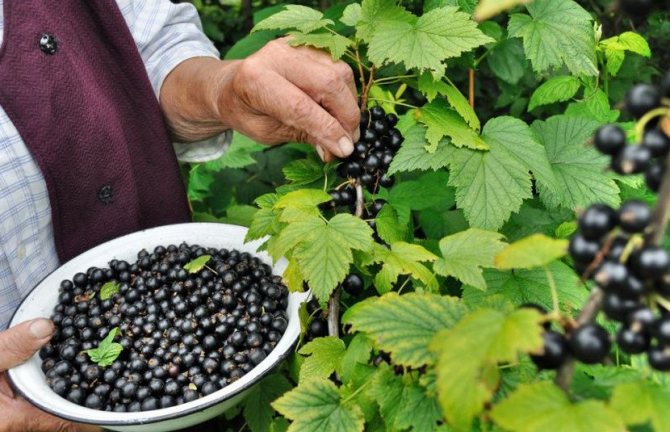

When picking currant berries from the branches, do not accumulate them in your palms, so as not to damage, because the thin skin breaks easily, as a result of which the product deteriorates. You should also not pour the harvested crop from one container to another. The berries are poorly transported and retain their freshness for only 3 days.
Weather conditions can significantly correct this process. For example, a sunny season accompanies a fast condition, and a cold one, on the contrary, slows it down.
Intensive ripening of berries begins in the last weeks of July. You need to collect them right away, because after a few days they will overripe and fall from the branches. The taste of such specimens deteriorates significantly.
Advantages and disadvantages
The main positive qualities of the Yadrenaya black currant berry bush include:
- large-fruited;
- with good care and timely pruning, impressive yields can be harvested;
- this shrub is highly resistant to cold weather and perfectly tolerates heat and drought;
- early maturity - already in the first seasons after planting Yadrenaya seedlings, good harvests can be collected;
- high resistance to powdery mildew and kidney mites.
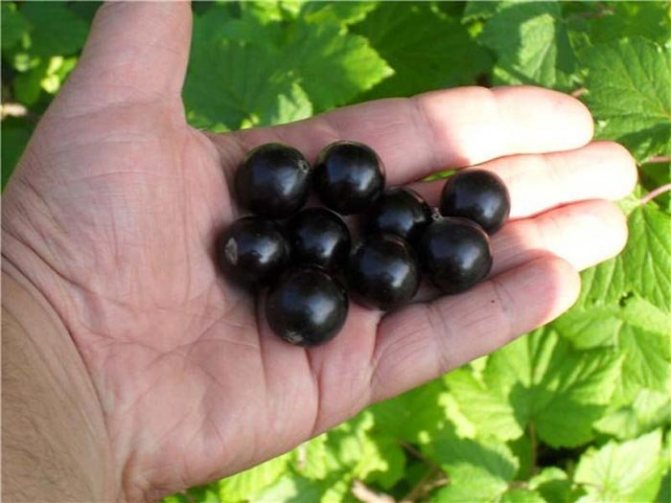

But many gardeners note the following negative qualities of this currant:
- sour taste of the harvested;
- bushes age quickly and reduce yields within 4-5 seasons after planting. Therefore, it is recommended to regularly form the bushes and carry out anti-aging pruning;
- anthracnose resistance is below average, therefore, in rainy seasons, it is necessary to carry out preventive treatments of bushes against this disease during the spring period and the first half of summer;
- sometimes uneven fruit ripening and a difference in the size of ripe berries are noted. But this may be the result of improper care of the shrub.
Gathering the harvest, many people understand that he could wish for the best, but not everyone knows how to achieve this. And the rules are simple and not difficult to follow.
What is sick and what pests are afraid of?
Resistant currant vigorous against powdery mildew, kidney mites. Almost does not get sick with rust and anthracnose. But at the first signs of these diseases and pests, you need to process the plant, otherwise the problem will worsen, since diseases, and even more so pests, spread quickly. Maybe not the bush itself, but the surrounding cultures will suffer from them.
Of the pests, the first to be feared is aphids. It appears in early summer and always makes itself felt with crowded and twisted leaves. You can process the culture from it by any means, since this is the beginning of the season, there are no berries yet, which means you cannot harm them. If the chosen remedy is good, then one treatment may be enough until the next year.
Adult plants get sick less often and treatment from pests is elementary - you need to remove the affected areas, if desired, carry out preventive, complex treatment.
Diseases and pests
Blackcurrant Vigorous is highly resistant to powdery mildew and kidney mites. But its resistance to anthracnose is very low. Therefore, it is recommended to carry out regular preventive treatment of the aerial part with fungicides or Bordeaux mixture in the spring, as well as in the first month of summer.
Interesting!
• How to get rid of aphids on currants
Planting currants
So, you decided that the Yadrenaya currant should settle on the personal plot. In this case, a description of the process of planting seedlings will not be superfluous. Cuttings are planted in mid-September in dug up loose soil at a slight angle (45-50 degrees). At the same time, no more than two buds remain on the soil surface. Better if they are located on the side.
At the beginning of spring, shoots with a length of 1.5 - 2.5 centimeters are formed from the buds. At this time, it is advisable to make the first top dressing. What fertilizer does Vigorous currant like? Reviews of gardeners in this regard agree that the best feeding is a mixture of manure and urea (a tablespoon of urea is added to a bucket of manure). Such fertilization in early April will be the most effective. One bucket of top dressing goes for 10-12 cuttings. The second feeding is carried out in a couple of weeks, at the end of April, with the same composition. And finally, the last feeding can be done after another two weeks. More cuttings are not fed until autumn, however, if the summer turned out to be unsuccessful, and their growth is very slow, then the fourth top dressing is applied until the end of June.
Also, in the middle of summer, you should pinch the shoots. The tip of the shoot is broken with a nail and then removed. After this, the growth of the shoot stops and lateral processes appear.
During the season, ash can be periodically applied, the seedlings are very responsive to this fertilization. Ash is brought in at the rate of 1 bucket per 3 m of planting, sprinkle it near the base of the plantings.
Annual seedlings can be planted in autumn and spring. Plants are placed at a distance of 1.2-1.4 meters from each other.They dig a hole about 40 * 40 centimeters in size, apply organic fertilizers, peat, rotted sawdust, grass, sprinkle it with earth a little and put a seedling on top. Top dressing is carried out in the same way as in the case of cuttings, in early April. Three feedings with an interval of two weeks between each.
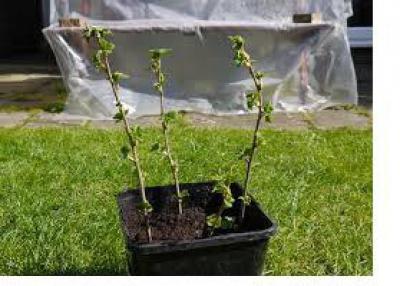

Adult currant bushes Yadrenaya from 4 years old require liquid feeding, 3-4 buckets per bush. It is held in mid-May, after flowering.
Pruning is carried out necessarily, removing unnecessary dry branches. The cut is treated with paint or garden varnish.
Reproduction of currant Vigorous
There are three methods for propagating currants:
- cuttings;
- layering;
- dividing the bush.
The simplest and most suitable way to propagate vigorous currants is by dividing the bush, since this shrub grows well and forms lateral processes that already have roots.
Photo of currant Yadrenaya
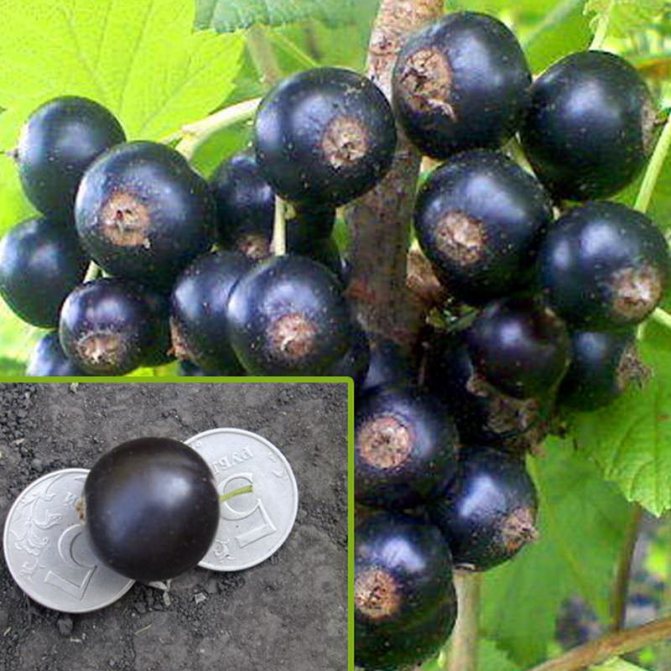

To obtain such a seedling, you need to carefully dig the currant bush from the side in order to get a part of the plant along with the root system. Next, you should treat the plant with a solution of potassium permanganate for the prevention of diseases by placing the bush in a liquid.
Then you should divide the dug out currant bush into the number of parts necessary for reproduction, making sure that each of them has a root system.
Further, the seedlings of vigorous currant bushes are placed in planting pits, dripped with soil, watered.
Planting currants can be carried out both in spring and autumn, but experts recommend that this procedure be carried out better in autumn.
Planting varieties
Currants take root well in a new place. To get a large harvest, it is necessary to thoroughly study the specific features of planting a seedling of a given culture.
The video shows how to plant black currants correctly. Photographed by Ivan Firsov.
Selection of seedlings
For planting, currant seedlings are chosen, which:
- not dried;
- not damaged during transportation;
- have a strong root system.
Selection of a site for disembarkation
The most suitable place for growing Yadrenaya is a place that is provided with warmth and sunlight, but a little partial shade is allowed. It is ideal to plant a variety of this currant so that from the north side the bush is covered by a building that protects the seedling from drafts. When cultivating currants in the cold or shade, the taste of the fruits obtained and their yield deteriorate significantly.
Currants love breathable, light soil. The best option is sandy loam, gray earth, podzolic soil.
Vigorous, unlike many berry crops, prefers slightly acidic soil.
Soils are also suitable for its cultivation:
- sod-podzolic;
- gray forest;
- medium loamy;
- sandy loam;
- rich in organic matter.
Planting pit preparation
First, prepare the landing site.
To do this, produce:
- weeding;
- digging;
- cleaning of stones, rhizomes and other debris.
A few weeks before the planned planting, a hole is dug 0.5m x 0.5m in size.
The depth of the pit depends on the fertility of the soil. If the soil is less fertile, then a deeper hole is dug and more humus is added to it.
The top about 20 cm of fertile soil is poured separately. Then 12 liters of humus or rotted manure, 35 g of potassium nitrate and 100 g of superphosphate are added to it. Another way is to add chemical fertilizers containing phosphorus and potassium.
Fertilizers containing phosphorus and potassium include:
- nitrophoska;
- Fall;
- ABA.
Disembarkation dates
Gardeners planted this variety of currants both in autumn (before September 15) and in spring (before bud break). When planting in the fall, the seedling is already adapting to its new habitat before the first frost. Spring planting is characterized by an intensive build-up of green mass.Therefore, he does not have enough strength to grow and strengthen the root system.
Preparation of seedlings
Before planting a seedling in a permanent place (about 12 hours), disinfect its roots. To do this, dip them in a slightly pink solution of potassium permanganate.
Before planting a seedling, its roots can be dipped in one of the solutions to stimulate growth:
- Topaz drug;
- potassium humate;
- Epin drug.
When 2 hours remain before the procedure, fresh cow dung is taken and mixed with clay powder (to the consistency of thick sour cream). The roots of the seedling are dipped into this mass, after which they are taken out and dried in the sun.
Landing technique
The process of planting currants includes:
- Good soil moisture.
- A seedling is carefully placed in a mound of soil. Straighten the roots so that they do not stick up.
- Little by little, the remaining bad soil is poured. When the hole is completely covered with earth, the root collar of the currant should be 7 cm below the ground level. The seedling should be slightly inclined, which contributes to the emergence of new shoots. A seedling is planted vertically to obtain a compact bush.
- All plants are pruned by about 2/3 of their length. This leaves 3 or 4 leaf buds.
- Water the seedling with warm water (up to 5 liters per plant). After waiting for the water to be absorbed into the soil, sprinkle it with straw, hay or dry peat on top.
When planting several plants, the gap should be about 2 m, and the row spacing should be from 2 to 2.5 m.
Black currant Vigorous: planting and growing
Experts recommend planting Yadrenaya black currants in the autumn - about a month before the onset of cold weather. When planting in the spring, the bushes adapt for a long time in a new place, get sick.
It is best to purchase annual seedlings of Yadrenaya currant for planting, which have grown at least 3 shoots and have a well-branched root system.
Important!
Before planting, no fertilizers are placed in the holes, as they can burn the delicate roots of the currant.
But when planting Yadrenaya currants in the fall, in the spring, humus or compost (at the rate of 5 kg per square square) should be added to the site where this shrub is planned to be planted for digging.
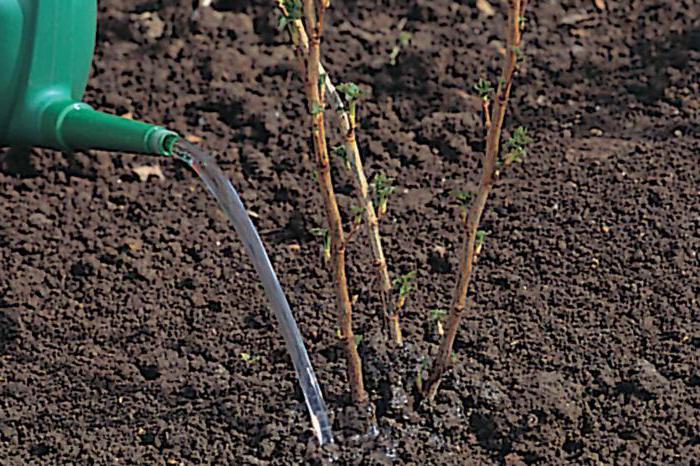

The scheme of planting currants Vigorous is as follows:
the distance between the planting holes in a row must be at least 1 m, and the row spacing must be at least 1.8-2.0 m.
The seedlings are placed in the center of the dug holes, the roots are straightened, covered with a nutritious substrate and watered abundantly. Shoots are shortened after planting, leaving no more than 3 buds on each.
Author's addition:
Black currant Vigorous is not afraid of frost, but still planting varieties of different fruiting periods on the site will reduce the risk of a decrease in yield for various reasons, depending on weather conditions. The shrub is planted at a distance of 1 m from each other so that all the bushes are evenly illuminated by the sun and do not compete with each other for nutrients in the soil. Currants do not like acidic soil, and it must be corrected by liming.
Planting currants - video
Agrotechnics
Black currants can take root in any area and bear fruit to one degree or another. But in order for the shrubs to be productive, experts advise planting them in a specially prepared place and regularly looking after them.
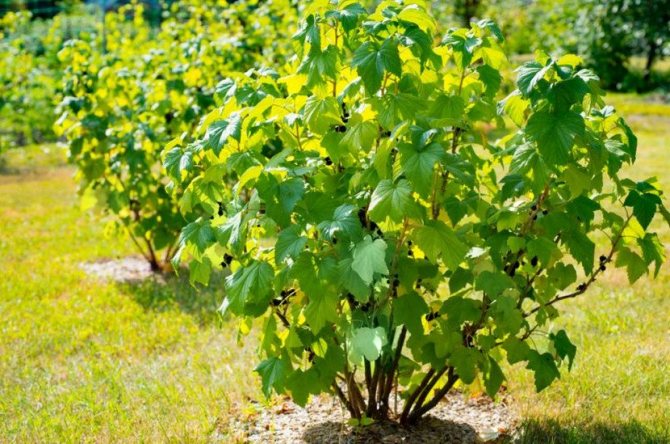

Success in growing the Yadrenaya variety guarantees a scrupulous, competent choice of seedlings and planting sites, as well as regular care.
It consists in timely watering, top dressing, preventive spraying, pruning and preparation of young bushes for wintering. The quality and timeliness of all the work carried out in the berry is especially relevant in the first years after planting.
Seat selection
To obtain an annual stable harvest, experienced gardeners advise, when choosing a place for planting a currant berry, to pay attention to the following nuances:
- the illumination of the site and its protection from through winds (preferably a sun-drenched or semi-shady hill, where rain and melt water, as well as cold air, do not collect);
- fertility and looseness of soils (it is advisable to choose nutritious chernozems with neutral acidity);
- the level of soil moisture (due to the fact that the bushes are not characterized by deep roots, moderately moist areas are preferable, while swampiness should be avoided, since dampness is a reliable conductor of fungal infections);
- predecessors and neighbors (currants develop poorly after, and also near sea buckthorn, cherries, walnuts, gooseberries and raspberries, all other berry and vegetable crops are good predecessors for it).
Important! Ideally, if in the area selected for currants, the soil warms up well during the day, and it contains a minimum amount of potassium carbonate. In excess, this soil component can become the main cause of the development of chlorosis.
.
Landing
It is better to plant Nucleus according to the scheme 3.0 × 1.0 m. The size of the planting pit should correspond to the root system of the seedlings and in no case should it be constrained. The roots are preliminarily treated with any growth stimulant (Kornevin, Ecosil), and the deepening is fertilized with humus or compost (usually 5–6 kg are used for this purpose).
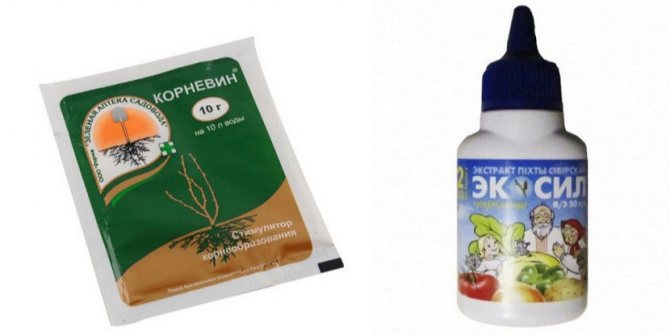

Planting can be planned both in spring and autumn. There is no significant difference, however, there are some subtleties that affect the further productivity of the berry plant being laid:
- In the spring, it is imperative to wait for the soil and air to warm up to a temperature of at least + 12 ° C. When rooting in spring, abundant watering is important. To protect the bush from drying out caused by the weathering of ground moisture, it is recommended to water the bush when planting until the ground absorbs moisture.
- In autumn, it is advisable to plant at least 2-3 weeks before the onset of frost. This period is enough for the roots to adapt to the new environment and not die during the period of decreasing temperature. Abundant watering during this period is inappropriate, since excessive moisture can provoke an intensive build-up of biomass and, as a result, freezing of the fragile root system. This method of rooting seedlings is recommended for varieties with high frost resistance, especially when it comes to regions with a harsh climate.
Did you know? The official name "ribes" was given to the currant by the Arabs. In ancient times, they conquered the Spanish lands and, to their horror, did not find their favorite rhubarb on them. However, the smell and sour taste of currant fruits reminded the conquerors of rhubarb.
Soil care
For stable fruiting and full development, currants need:
- moderate moisture;
- nutrients;
- loose high-quality soil.
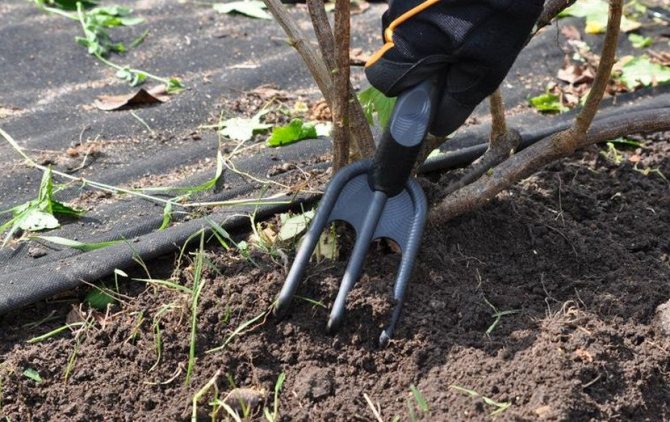

Some gardeners are skeptical about the requirements of regular weeding and loosening of the soil in the garden, regarding them as aesthetic nuances. Experts say that it is impossible to get a good harvest in a weedy berry.
The unproductiveness of the bushes is explained by the competition for nutrients in the soil, which, in the overwhelming majority, are spent on the growth of unnecessary vegetation. In addition, weeds attract pests, which are the best carriers of fungal and bacterial diseases.
Read about planting currants outdoors.
Under the currants, it is important to periodically loosen the soil to a depth of 10–12 cm. You should not go too deep, since the fibrous roots of the bushes grow strongly to the sides and can be damaged during processing. It is enough to destroy the top crust on the garden soil with a glanders. This will promote aeration of the root system, which in turn will ensure proportional plant growth.
Watering Features: Spring, Summer, Autumn
The variety belongs to the insensitive group of fruit and berry crops to prolonged moisture deficit.However, only adult plants can painlessly survive a drought, and young bushes under such conditions are prone to death. To prevent premature wilting of the formed ovary, the berry must be watered periodically.
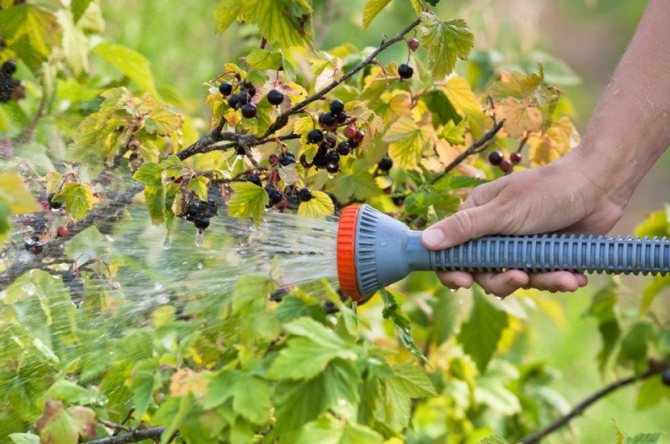

Intensive watering for immature seedlings is shown in the first 2 months after spring planting (in the case of autumn rooting, in April and May).
In addition, a sufficient amount of moisture for a Nucleus of any age is necessary during the flowering period, the formation of the ovary and the ripening of the crop, so take into account the weather characteristics of the region where the crop is grown, and monitor the condition of the soil on the plantation. It should be moderately moist, but by no means dry or waterlogged.
Important! To prevent the development of weeds, it is advisable to cover the soil in the berry with mulch after watering. For these purposes, coniferous materials are categorically contraindicated, since they cause soil oxidation.
It is strictly forbidden to use cold water for watering. Be sure to let it settle and warm up in direct sunlight for 48 hours. In the summer, after harvesting, currant bushes require abundant watering, since this procedure affects the laying of future berries. The procedure should also be repeated in September, when the bush begins to prepare for the coming cold weather.
Top dressing: before, during and after fruiting
Experienced gardeners advise to sow mustard in the aisles of the berry plant as a siderat in the first 2 years of the seedlings' life to replenish the soil, and in the future this area should be kept under black steam.


In spring, the bushes need nitrogenous components, which stimulates the growth of biomass. It will be useful to water with a solution of chicken manure (it is prepared in a ratio of 1: 5), as well as the introduction of urea, ammonium nitrate (for every 1 m² of plot, 20 g of fertilizer is required).
Learn how to feed starch to currants.
The second and third dressings are carried out with an interval of 14 days and provide for the introduction of potash fertilizers (40 g of potassium sulfate is required per 1 m²). Their main task is to prepare the bushes for winter and future fruiting.
Disease and pest control
In most cases, the Yadrenaya variety demonstrates high sensitivity to powdery mildew pathogens, as well as to attacks of soil mites. In case of infection, the first symptomatology cannot be neglected. If you do not take timely measures, you can lose the plant.
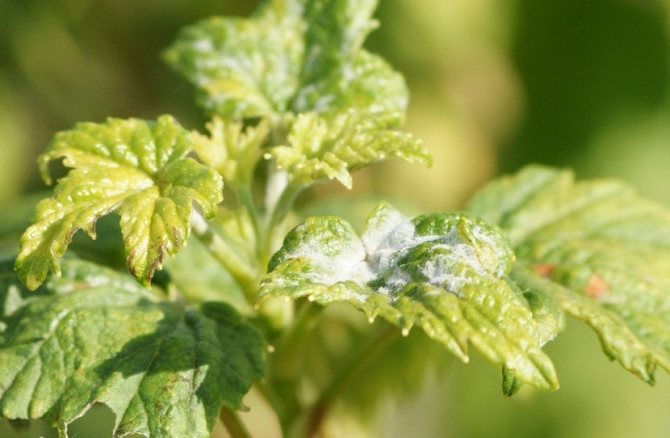

Due to the fact that breeders at the genetic level have taken care of the resistance of this variety of black currant to common diseases and pests, it is not difficult to grow it.
Subject to agrotechnical rules, the culture does not require additional measures. And in regions where epidemic outbreaks of diseases are observed, spring and autumn spraying should be carried out to prevent infection of the bushes.
To combat fungi and bacteria, the following solutions are recommended:
- Bordeaux liquid (1%);
- copper sulfate (5%);
- colloidal sulfur (1%);
- fungicides "Skor", "Maxim" (prepared strictly according to the recommendations of the manufacturers).
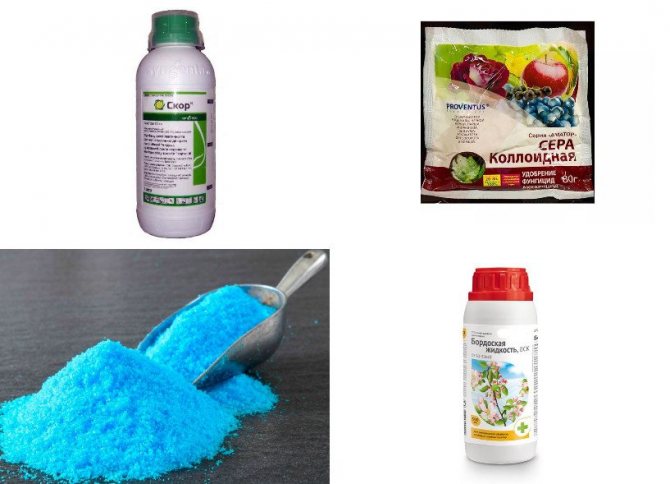

It is important that pesticides do not get on the fruits, therefore, preventive treatment of plants is relevant before their flowering, as well as after harvesting. In case of emergency treatment, be sure to read the instructions for use, paying attention to the decay time of the active substances.
Keep in mind that remedial measures include the complete elimination of damaged areas of the bushes and further disinfection, which is carried out several times at intervals of 14 days until the problem disappears completely. In addition, it will be necessary to analyze the causes of the development of pathogens and completely exclude conditions that promote their activity.
Did you know? The Slavs began purposeful cultivation of currant bushes in the distant 11th century.The chronicles of that time indicate that the berries grew only in monasteries, so the currant was then called the "monastery berry". Initially, the fruit was used for the preparation of medicines, and since the harvests were generous, the product was introduced into the kitchen for processing and making sweets.
In case of increased activity of harmful insects in the garden, you can protect the berry from their harmful effects with the help of any insecticides. "Aktara", "Aktellik", "Fitoverm" have proven themselves well.
Pruning and shaping the bush
Currant bushes of the Yadrenaya variety are shown annual formative and rejuvenating pruning, which should be carried out strictly according to the scheme below:
- 1st year - most of the shoots are cut off, leaving 10-15 cm from the ground (it is important that each shoot has 2-4 well-developed buds);
- 2nd year - all small shoots are radically removed, as well as unripe and weakened branches (frozen and damaged shoots are subject to elimination), no more than 4 most developed shoots of the zero order should be left, from which the skeleton of the bush will be formed in the future;
- 3rd year - 4–5 of the most promising branches are selected from the emerging branches of the first order, and the rest are removed;
- 4th year - a currant bush is formed so that it consists of 15–20 skeletal branches;
- 5th year and beyond - the bushes require annual rejuvenating and sanitary pruning, which consists in the elimination of dry, damaged, old and competing shoots.
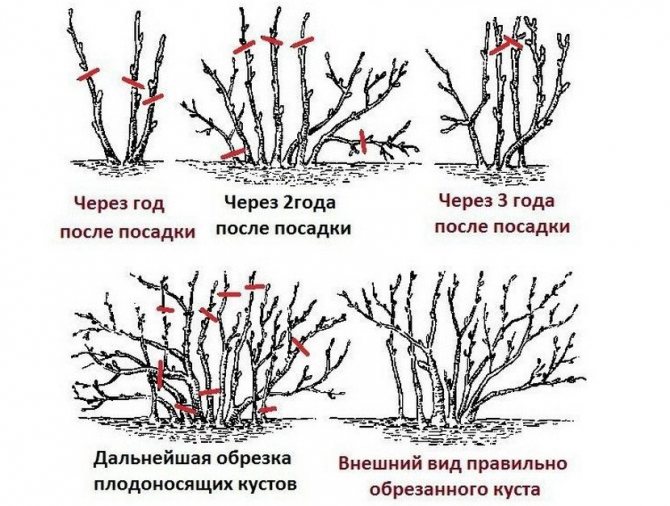

Wintering
Adult currants tolerate winter well and do not require additional preparation for cold weather. But young seedlings can suffer from severe frosts, so it is important to water them abundantly and fertilize them with phosphorus-potassium mineral fertilizers in the fall. Make sure that the packaging is labeled "autumn", otherwise the bushes will begin to intensively build up green biomass, which will die with a minimum drop in temperature.
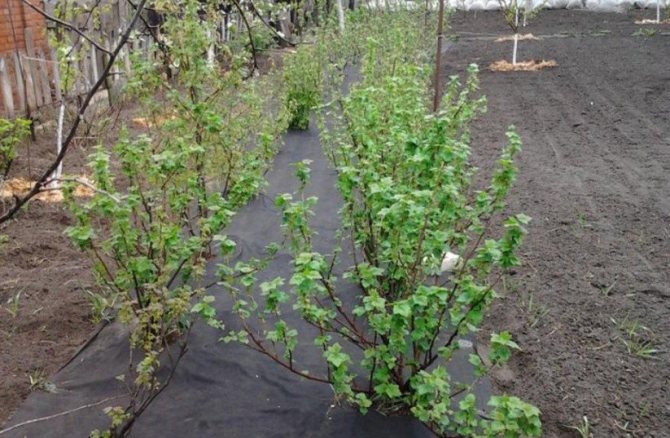

If necessary, seedlings can be wrapped with agrofibre or spruce branches. This is an excellent way to protect the plant from hungry rodents.
In the Altai Territory and the regions located near Siberia, it is recommended in the second half of autumn to mulch the berry with a layer of high-moor peat, sawdust, hay or straw. The thickness of the mulch should be 10-15 cm.
Important! To alkalize the soil in the garden, it is recommended to apply 150 to 300 g of slaked lime or dolomite flour for each square meter every 3-4 years.
Further care of currant varieties Yadrenaya
This currant is very fond of watering, does not tolerate a long period of drought, therefore, immediately after watering, a layer of mulch must be applied to the near-trunk circle. As a mulching element, you can use:
- wood chips;
- rotted sawdust;
- nutshells;
- straw;
- cut grass or dried weeds.
Author's addition:
Watering vigorous currants is especially important in dry summers with little rainfall. It is not necessary to water the currants every day, but 3 waterings during the growing season must be carried out. The first time the currants are watered at the end of flowering, the second watering is carried out after 2 weeks, when the ovary appears, and the third - when the berries ripen. At least four buckets of water are poured under each bush.
If the weather is dry, then this shrub should be watered every 7 days, adding at least 10 liters of water to each plant.
How to plant and grow Vigorous on the site
To grow healthy and productive currants Yadrenaya, you will need to comply with the basic conditions of agricultural technology and care. Important aspects of the process are: selection of a suitable seedling, watering and pruning.
Choosing a healthy seedling
To choose a healthy, strong seedling, it is recommended to be guided by the following principles:
- there are no damages, traces of mold or rot on the root system of the plant;
- the trunk is young, green in color, with slight woodiness, which can be easily removed with a fingernail;
- the twig is even, without scratches or visible damage.
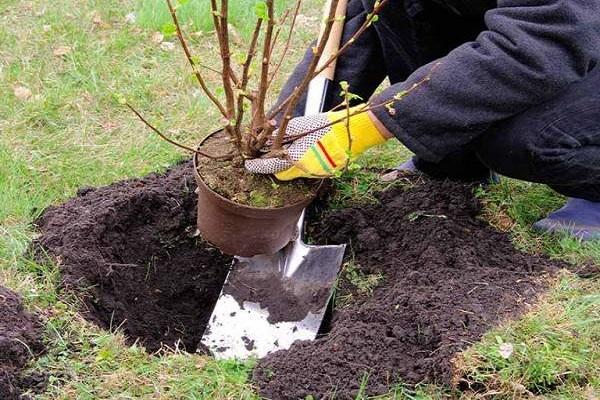

Choosing the best place
Vigorous currant does not tolerate root moisture, this provokes rot and the occurrence of infection, therefore it is recommended to choose the right planting site. It is better to give preference to small hills and hills. It is also not recommended to plant a bush in a well-ventilated area. Berries from the wind will quickly sprinkle under their weight.
Additionally, it is required to provide the hybrid with sufficient sunlight, so it is not recommended to plant plants near taller bushes and trees.
Soil preparation
It is advisable to fertilize the soil for future planting with humus or manure several months before the procedure. Then, 10 days before planting the seedling, it is recommended to take care of creating a suitable pit. The hole is dug about 50x80 in size and 20 centimeters deep.
Important! It is required to create a small drainage and fill the hole with 2-3 buckets of water to allow the earth to settle.
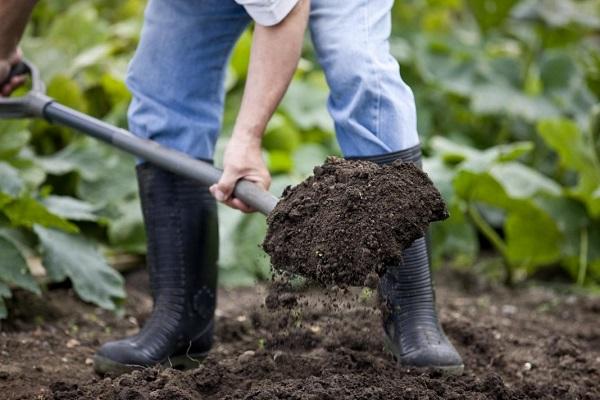

Timing and technology of planting bushes
You can plant Yadrenaya currants both in spring and in autumn (in the first half of October). The main thing is that the soil temperature is at least 10 degrees. If several bushes are planned to be planted on the site, it is important to follow the planting scheme. The average distance between plants should be at least two meters. It is not recommended to plant currants near trees and tall bushes.
Top dressing currants
In the spring, the mulch layer is removed, and 10 kg of humus or compost is added under each Yadrenaya currant plant, leveled over the entire trunk circle, then the mulch layer is again scattered under the bush.
You can also use nitrophoska or nitroammophoska (40 g for each plant) as fertilizer.
GARDEN FERTILIZERS!
• Nitrogen fertilizer Urea • Potassium monophosphate • Azofoska • Ammofoska
Author's addition:
Ideally, black currants are fed 4 times per season. After budding, ammonium nitrate is used: 2 tablespoons of fertilizer are diluted in 10 liters of water and poured under the bush. In mid-June, for feeding, take 1 spoon of urea, 1.5 tablespoons of superphosphate and 0.5 tablespoons of potassium sulfate on a bucket of water. Also, fertilizer is poured into a bucket under each currant bush. At the end of September, the Yadrenaya currants are fed again with superphosphate and potassium sulfate. Take 0.5 cups of each type of fertilizer per bucket of water. In October, the trunks of the bush are mulched with rotted manure.
If gardeners do not have enough experience in caring for currant bushes, then it is better not to feed this shrub “on the leaf” with a solution of mullein or bird droppings, since if the dosage is incorrect, you can burn the leaf plates than ruin the bush.
Landing features
Blackcurrant Cherry prefers moist soils. For planting, it is advisable to choose a sunny or slightly shaded area, sheltered from the wind.
It is advisable to start planting currants closer to autumn, and even better - in mid-September. All planting work must be completed by October. During this time, the bush will root well, the earth will settle tightly during the winter period and in the spring the plant will grow.
Planting is possible in spring, but it should be started as early as possible. It is necessary to plant the plant before bud break, as soon as the thawed earth allows.
Sapling selection
Seedlings in specialized stores and nurseries are sold in pots with a substrate and individual shoots with a bare root system. These are usually annual plants.
It is imperative to pay attention to the root system. It should be well developed, not dry or rotten, without visible damage.
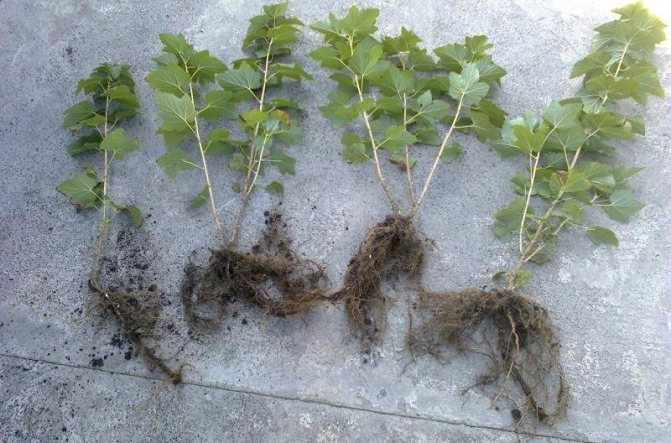

A currant seedling should have a lot of fibrous (thin) roots
Step-by-step process of planting currants
- A landing pit is prepared 2 weeks before planting.They dig up the soil on the bayonet of the shovel, remove the weeds. The depth of the hole should be about half a meter and of such a diameter that the root system of the plant can be freely placed in it.
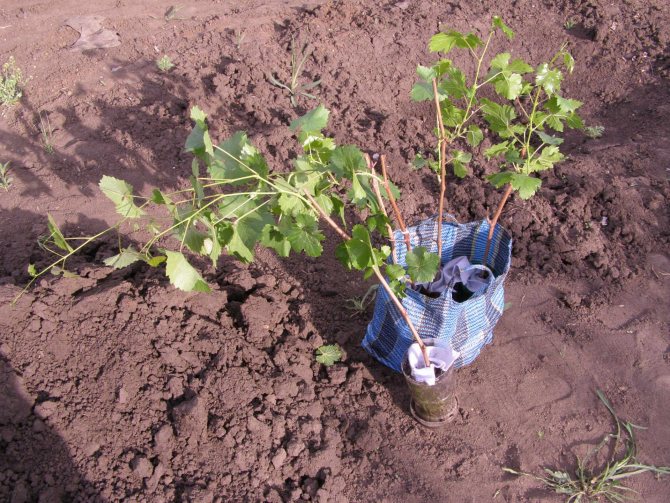

Before planting seedlings, the soil must be prepared: level, dig deep, fertilize - The optimum distance between the planting pits is 1.8–2 m. So the plants will not interfere with each other in adulthood.
- Pour a bucket of humus, 100 g of superphosphate, a half-liter can of ash into the pit, add earth and mix everything thoroughly.
- The plant is placed in a planting hole in such a way that the roots are freely and evenly placed over its entire area. It is necessary to make sure that the roots are buried by 5–7 cm when covered with soil. With such a planting, the root system develops better, and the seedling grows faster and becomes thicker.
- After planting, the plant is watered abundantly, while carefully compacting the ground, being careful not to damage the roots of the seedling. It is advisable to immediately mulch the trunk circle. Peat or sawdust can be used as mulch.
- After the young bush is planted, it needs to be pruned. Usually 2-3 buds are left above the ground. This radical pruning gives the plant the ability to quickly develop a root system, and the bush will be well branched.
Currant pruning Vigorous
It is necessary to prune bushes of black currant Yadrenaya more often than other fruit bushes, since its shoots age faster
... Already on four-year-old shoots, much fewer brushes with ovaries are formed, and the main crop is harvested from 2 and 3-year-old stems.
Important!
For the first time, currant shoots are cut when planting seedlings, leaving no more than 3 buds on the stems. From these buds, new shoots are formed next year, which are shortened by about half in the spring.
From the third season, pruning is carried out according to the following principle
: Leave no more than 3 new shoots growing from the root while removing 3 old shoots at the same time. At the same time, stumps are not left, removing the stem under the root.
Also, sanitary pruning of currant shrubs is carried out.
, during which all old, damaged, weak and diseased shoots are removed.
Author's addition:
The largest number of berries is given by two-year and three-year currant shoots. The older the branches, the lower the yield on them, therefore, when forming the plant, you should carry out regular pruning, leaving 4 annual shoots, and cut out the shoots older than 6 years. Currant pruning is carried out in autumn after foliage has fallen.
Correct pruning of black currants
Pruning is carried out in the spring, when the stems damaged during the winter are removed. Also, the stems are cut at the end of the harvest, while those shoots on which practically no ovaries have formed during the season are subject to pruning.
Author's addition:
Attracting bees. Currants are pollinated by bees and, in order to attract them, the bushes are sprayed with a honey solution (diluted in 1 liter of water 1 tablespoon of honey)
Care
Watering and loosening
In order for the currants to give a large harvest every year, the bush needs moist soil. In general, for the entire summer season, currants need careful watering about 4 times... In early spring, before flowering begins, the roots need moisture. The second time the currant needs watering during the ripening of the fruit. Another careful watering should be done after harvesting and, finally, the last time the shrub needs to be well drilled at the end of September. Throughout the summer, especially in hot weather, the bush can be watered as the soil dries up.
Overflowing the soil around the currants threatens root rot, especially young ones, as well as the development of many diseases. It is better to water the seedlings at night, because morning and afternoon watering is not absorbed into the soil, but simply evaporates from the surface.
Loosening should be done a couple of days after watering.... Loosening provides additional oxygen to the roots, also removes weeds and helps to get rid of many soil pests.
Top dressing
Fertilization of currants begins from the 2nd year after planting, if fertilizers were applied to the planting pit during planting. It is better to feed at least 2 times a year.... In the spring, it is good to feed the currants with urea, manure or peat. Currant also responds favorably to sawdust and ash. During the summer, under a young bush, you need to add a solution from a barn, mineral, potash or phosphorus fertilizers - this will increase the size of the berries.
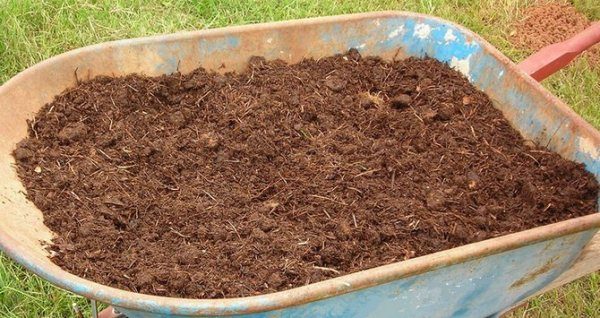

Fertilizing of Poisonous Currants should be done at least twice a year.
In the fall, half a bucket of humus can be brought under the bush... It is worth noting that you cannot simply pour the top dressing onto the ground. To do this, you need to dig a small trench around the bush, apply fertilizer and dig it up with the ground.
In order for the fertilizer to better penetrate the soil, after feeding the currants need to be well watered.
Pruning
Currant pruning is done in spring before bud break and in autumn... In the first year, pruning is not carried out because the seedlings are still too small. On the 2nd year the currant bush is already forming 3-5 main strong shoots, the rest of the young branches are cut out. The tips of the remaining branches are shortened by 2-3 buds.
Currant pruning scheme Variety Yadrenaya
At first glance, pruning a young bush so much is dangerous, because the plant can become very sick and die. But this is not so, pruning will allow the shrub to not waste energy on shoots that do not yield a crop, besides pruning allows you to increase the size of the berries, and increase the amount of harvest. On the 3-4 years 5-6 strong shoots are left. The branches that were formed last year are shortened to 3-4 buds, the rest of the length is cut out. On the 5-6 years trimming occurs in the same way. Sanitary pruning is necessary in the fall., namely, to cut out branches that are broken, damaged by diseases and pests, as well as shading fruit-bearing branches.
Preparing for winter
Currant variety Vigorous belongs to frost-resistant varieties, tolerates low temperatures well and is not afraid of frost. In the fall, the trunk circle must be dug, this will destroy all insects that like to hibernate in the roots of the plant.
Also, the trunk of a currant can be overlaid with spruce branches or laid with covering material, but basically only young seedlings need such a shelter, adult bushes winter well without shelter. But currant branches must be tied up with ropes, moving in a spiral - this will protect them from floors in strong winds.
Benefits of the variety
Currant Yadrenaya is a frost-resistant variety, it is able to withstand rather large fluctuations in temperature. Resistant to pests and diseases. Reproduces well.
The variety is good for harvesting berries with sugar, making stewed fruit and jam.
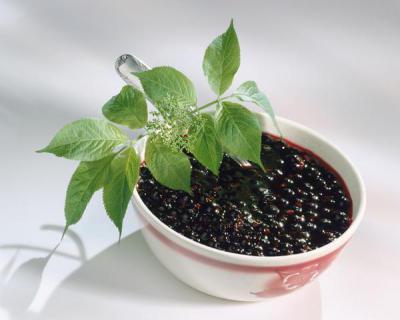

Berries have a sour taste, as they contain organic acids, a little sugar and a large amount of ascorbic acid.
Read also: Cherry Meeting: description of the variety, photos, reviews, winter hardiness
If you delay the harvest, the berries acquire a sweeter, dessert taste.

